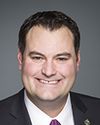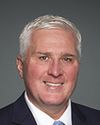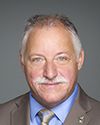Thank you, Mr. Chair. I know we're tight for time given what is happening in the House, so I'll go at Newfoundland speed through my opening comments.
I think this is a different department from what it was three years ago. We are driven by a new vision and a sharp focus on the overall well-being of our brave Canadian Armed Forces members, veterans, and their families. We immediately reopened front-line points of contact closed by the previous government. We started staffing up after years of cuts. We brought benefits into line with where they should have been for years. Year over year, since we came into office, we have been committing more money to veterans' programs and benefits, ensuring more and better support for veterans and their families.
Our overarching purpose is to enhance the well-being of veterans so that they can make a successful transition to life after military service. Our commitment is clear. You can see it in these main estimates. An important consideration is that 90% of our budget, 90% of what you see in the numbers before you, go directly to veterans and their families.
The past three departmental budgets reflect the efforts we've made to make sure that we treat our veterans with the care, the compassion, and the respect they have earned. We have used our resources to reopen the nine Veterans Affairs offices that had been closed, and we opened a new one. We hired more than 460 staff across the country to deal directly with veterans and deliver services where and when they need them. We increased outreach in the north. We opened new operational stress injury clinics to help veterans with service-related disabilities.
We increased the amounts of benefits veterans received. We refocused them to address real-world needs. We continue to do that. As you will see, everything in the main estimates goes to improving the well-being of veterans and their families. For example, on April 1 this year, we launched eight new or enhanced benefits that address education and training, financial security, and families and their well-being. Really, they are all designed to enhance veterans' well-being.
The new caregiver recognition benefit provides a monthly payment to people who provide care to veterans with a service-related illness or injury, and we have expanded access to the military family resource centres for veterans' families. These new programs are central to the recognition of the importance of families and caregivers in veterans' quality of life.
For veterans, the department will pay for education and training to help them get the careers they want. If they want guidance about what path might be best for them, we're providing career counselling and job resources. Since April 1, 2018, nearly 400 veterans have been approved for the education and training benefit, and more than 350 CAF members and veterans are already working with career transition services. The new veterans emergency fund provides immediate financial support to deal with urgent and unforeseen circumstances.
Two weeks ago, I was able to announce that with the Royal Ottawa Health Care Group, we are setting up a centre of excellence on post-traumatic stress disorder and related mental health conditions. This centre will create and share knowledge of veterans' mental health treatments that work and place that knowledge directly into the hands of mental health professionals and others working with veterans on a daily basis right across the country.
Last December, I announced that we will fulfill another item in my mandate letter when we restore the pension for life option for ill and injured veterans by April 1, 2019.
I want to tell you about another driver of change at Veterans Affairs Canada. It's about listening to veterans, families, and their advocates. It's about hearing them and taking action on what they tell us. I have held town halls in provinces from coast to coast to hear first-hand the concerns and inputs of veterans and their families, and I will continue to do that through the summer. We have made, and continue to make, changes to respond to those concerns. We are continuing to improve.
For years, veterans have been telling the department that it can be difficult to navigate through all these programs and processes. We've improved our approach and our people are informing and helping veterans access the benefits they are eligible for. We reach out actively to the veterans community to make sure that they know what they're eligible to receive and then we help them get it.
The effects of this about-face are showing up in the numbers. The main estimates for the coming year show increased demand for treatment benefits. The reason for this is that more veterans are applying for and receiving benefits. That is a good thing. It shows that our increased efforts in communicating and reaching out are starting to have a positive effect.
In the coming year, we are enhancing our benefits and programs further. Recognizing costs for psychiatric service dogs in the medical expense tax credit will help veterans cope with things like PTSD.
We are not forgetting our commitment of keeping alive the memory of the achievements and sacrifices of the men and women who have served our country in times of war, conflict, and peace. This year, we are commemorating the centennial of the end of the First World War and Canada's contributions to the last hundred days that led up to the end of the hostilities. We will also mark the 65th anniversary of the Korean War armistice, and we're investing $24.4 million to eliminate the backlog in repair and maintenance of some 45,000 veterans' graves.
We're going to continue to listen to veterans to hear their concerns and to take action. We're going to hold more summits across the country, where veterans and their advocates can tell us their concerns, and tell us how they think we're doing.
Listening—it seems like such an obvious thing, a simple thing, and yet it is a very powerful thing. By following through on our promises, we are demonstrating our powerful commitment to those who have served Canada proudly.
Veterans today are not the same as the veterans of the 20th century. The needs of the veterans' community will continue to evolve. Their needs, and needs of their families and caregivers, will also evolve. This department will continue to evolve to ensure we are meeting their needs, enhancing their well-being, and helping them to successfully re-establish in life after service.
Thank you.











